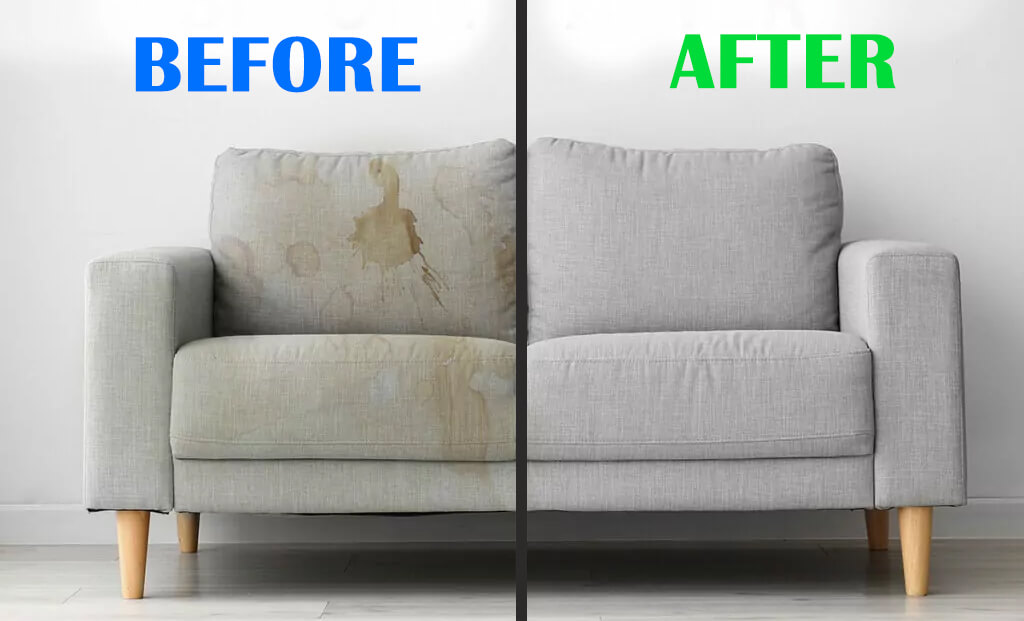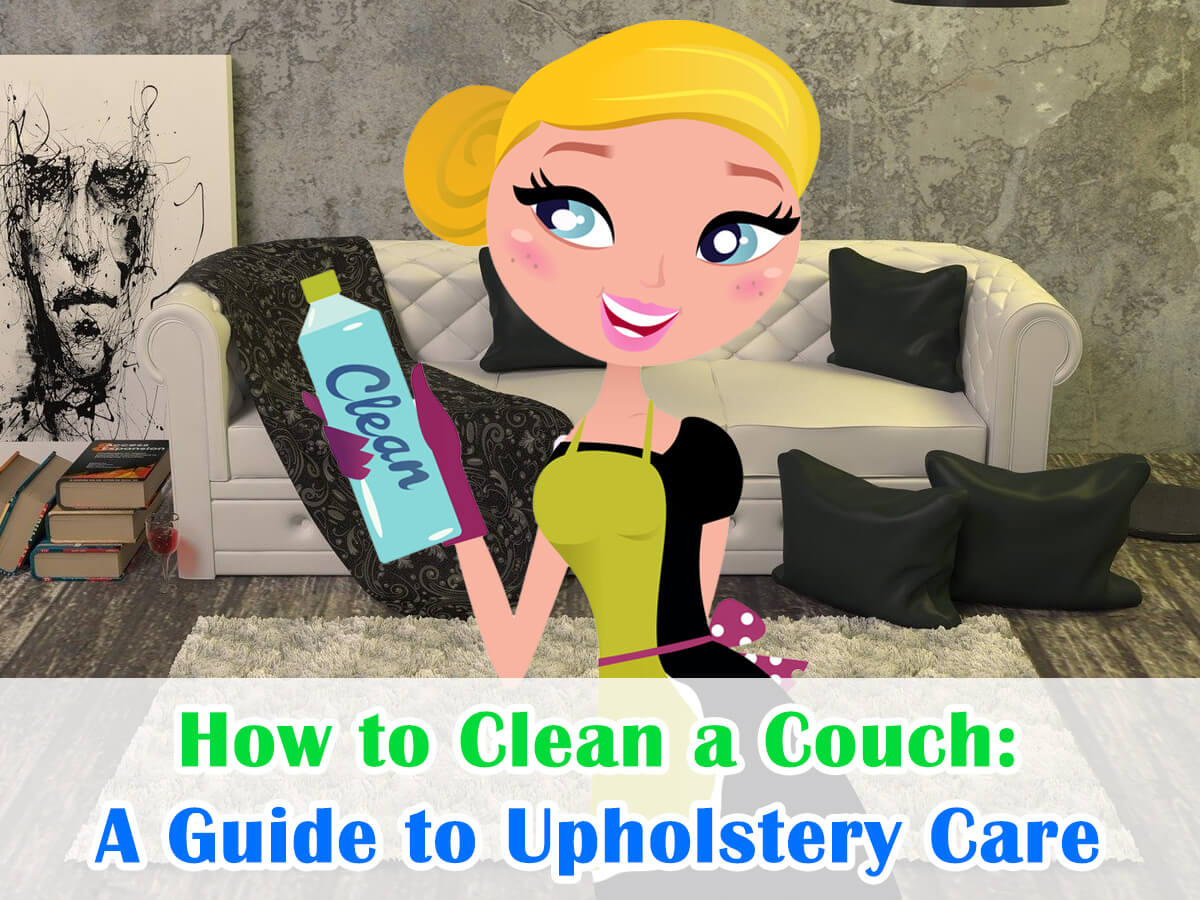Everyone has that one spot on their couch. Maybe it’s where you accidentally spilled your morning coffee, or perhaps it’s the inevitable result of your dog’s favorite lounging place. It’s a constant reminder of everyday life taking its toll on your beloved furniture. As someone who cherishes the state of their home, I know that struggle all too well.
The good news? Your couch doesn’t have to remain a canvas of your clumsy moments and your pet’s dirty paws. In this article, I’m going to guide you step-by-step on how to clean a couch effectively, without damaging its fabric or color.
How to Clean a Couch
1. Identify the Fabric
First things first, we need to identify the fabric of your couch or sofa. This step is crucial because different fabrics require different cleaning methods. Look for a tag on your couch with cleaning instructions and codes. You might find a ‘W’ for water-based cleaning solutions, ‘S’ for solvent-based cleaners, ‘WS’ for either, and ‘X’ for professional cleaning only.
If the tag is missing, don’t worry. You can usually identify the fabric by its feel and appearance. Synthetic materials like microfiber and nylon feel coarser and more textured, while natural fabrics like cotton, silk, or linen have a smoother feel. Leather and faux leather couches have a distinctive, somewhat slippery touch.
Remember: When in doubt, it’s always best to test any cleaning product or method on a small, hidden area of the couch before proceeding.
2. Gather Your Cleaning Supplies
Once you’ve identified the fabric of your couch, the next step is to gather the appropriate cleaning supplies. This crucial stage ensures that you have everything on hand to effectively and safely clean your couch. These supplies not only make the task more efficient but also help safeguard your couch’s fabric, ensuring it remains in the best possible condition. So, take a moment to check your couch’s care label or determine its fabric type, and then assemble the necessary cleaning supplies to embark on a successful cleaning journey.
- For water-based cleaning, you’ll need a bucket of lukewarm water, gentle dish soap, a soft cloth, and a soft-bristle brush.
- For solvent-based cleaning, you’ll need a specific upholstery cleaner—there are plenty available on the market. The most recommended one is probably Chemical Guys Lightning Fast Upholstery Stain Extractor. It removes even the toughest stains without harming the fabric. It also takes care of unpleasant odors, replacing them with a fresh scent.
- For leather, opt for a good quality leather cleaning and conditioning product. I personally recommend going for TriNova Leather Cleaner for Couch, a highly popular product that has over 5,000 positive reviews on Amazon. It’s effective, easy-to-use, and perfectly safe for any leather surface.
Don’t forget about your vacuum cleaner with an upholstery attachment. Regardless of your couch’s fabric, the cleaning process should always begin with a thorough vacuuming to remove dust, crumbs, and pet hair. Remember to clean the crevices, too. Some bits and pieces often hide out in those hard-to-reach corners.
3. Start the Cleaning Process
Now, it’s time to roll up your sleeves and start cleaning. Since I have mentioned three types of cleaning earlier, let’s see the steps that each type requires.
Water-Based Cleaning:
- Spot-Clean Stains:
- Dip a soft cloth into the soapy water.
- Wring out excess water.
- Gently dab the stained area without scrubbing.
- Use a separate dry cloth to blot and absorb moisture.
- Rinse and Dry:
- Wipe the cleaned area with a clean, damp cloth to remove any soap residue.
- Use a dry cloth or towel to pat the area dry.
Solvent-Based Cleaning:
- Spot-Clean Stains:
- Apply a small amount of the solvent-based upholstery cleaner to a clean cloth.
- Gently blot the stained area with the cloth; avoid rubbing.
- Follow the product’s instructions for stain removal.
- Ventilate:
- Ensure the cleaned area is well-ventilated to allow the solvent to evaporate.
Leather Cleaning:
- Apply Leather Cleaner:
- Apply the leather cleaner using a circular motion.
- Ensure even coverage of the leather surface.
- Wipe and Buff:
- Use a clean, dry cloth to wipe off excess cleaner.
- Buff the leather gently to restore its shine.
- Apply Leather Conditioner:
- Follow the instructions for applying the leather conditioner to keep the leather soft and supple.
4. Deal with Stubborn Stains
Sometimes, regular cleaning methods just won’t cut it. If you’re dealing with stubborn stains, there are several home remedies to try.
- For fabric couches, consider a mix of equal parts white vinegar, dish soap, and warm water. Apply it sparingly to the stain and blot with a dry cloth.
- For leather, baking soda could be your saving grace. Make a paste with equal parts baking soda and water, apply it to the stain, let it sit for a few hours or overnight, and then wipe it off with a soft cloth.
5. Perform Regular Maintenance
Now that we’ve covered the basics of cleaning a couch, it’s important to remember that maintenance is key to prolonging its life. Regular vacuuming, immediate attention to spills, and professional deep-cleaning every couple of years will keep your couch looking its best.
Here are some tips to keep your couch looking its best:
| Maintenance Tip | Description | Frequency |
|---|---|---|
| Vacuum Regularly | Remove dust, crumbs, and debris from the couch’s surface and crevices before it can settle into the fabric. Use an upholstery attachment to get into crevices. | Weekly |
| Treat Stains Immediately | The sooner you tackle a spill, the less likely it is to turn into a stubborn stain. Keep your preferred cleaning solutions and tools handy. | As needed |
| Rotate Cushions | Distribute wear evenly by periodically rotating and flipping cushions. This can help prevent wear and tear from forming on frequently used spots | Monthly |
| Keep Food and Drink Away | Avoid eating or drinking on the couch to prevent spills. | Ongoing |
| Follow Fabric Care Instructions | Each material has its own care instructions. Following these can prolong the life of your couch. | As specified |
6. Protect and Preserve Your Couch
To ensure the longevity and pristine appearance of your couch, preventive measures play a pivotal role. Here are the steps to protect and preserve your couch’s beauty:
1. Shield with Slipcovers and Throws
Why? Slipcovers and throws are your first line of defense against spills, stains, and general wear and tear. They offer a practical solution, especially in households with kids and pets.
How?
- Select the Right Fit: Choose slipcovers that fit your couch snugly to ensure they stay in place.
- Easy to Clean: Opt for slipcovers and throws that are machine-washable for quick and convenient cleaning.
- Decorative Element: Use throws as decorative accents to enhance your couch’s style while protecting it.
2. Invest in Fabric Protection Sprays
Why? Fabric protection sprays act as a barrier against spills and stains, making it easier to clean and maintain your couch.
How?
- Choose the Appropriate Spray: Select a fabric protection spray suitable for your couch’s material, whether it’s fabric or leather.
- Even Application: Follow the product’s instructions to ensure an even application, usually by spraying from a distance and allowing it to dry.
- Repeat as Needed: Reapply the fabric protection spray periodically, especially after giving your couch a thorough clean.
3. Establish House Rules
Why? Preventive care isn’t just about products; it’s also about habits. Establishing house rules can go a long way in maintaining your couch.
How?
- No Food or Drinks: Make it a rule to avoid eating or drinking on the couch to reduce the risk of spills.
- Clean Hands and Paws: Clean pets’s paws after a walk and encourage family members to have clean hands when using the couch. This will minimize dirt and oils transferring onto the fabric.
- Regular Maintenance: Implement a schedule for regular vacuuming and spot-cleaning to address issues promptly.
By following these imperative preventive techniques, you can safeguard your couch from everyday challenges, ensuring it remains a comfortable and attractive centerpiece in your home for years to come. Remember, proactive care is the key to a cleaner and longer-lasting couch.
As a treat, here is a video that demonstrates satisfying results of couch cleaning:
A Deeper Dive into Couch Fabrics and Their Care
Each couch fabric has its own specific set of care instructions. Here’s a brief guide to some of the most common materials:
Cotton and Linen
Cotton and linen are popular for their comfort and durability. However, they can be prone to staining and fading. Regular vacuuming is vital to prevent dirt and dust from settling into the fibers. Spot-clean stains immediately using a water-based cleaning solution. Do not use too much water, as it can cause water rings or discoloration.
Synthetic Fabrics
Fabrics like nylon, polyester, and microfiber are typically more stain-resistant and easier to clean, making them a good choice for families with children or pets. They can usually be cleaned with mild, water-based solutions or specific upholstery cleaners.
Wool
Wool is less common for couches due to its high maintenance. It can shrink and distort when wet, so it’s best cleaned with a dry cleaning solvent or by professionals. Regular vacuuming and immediate stain treatment are essential.
Leather
Leather, both genuine and faux, requires special care. It needs to be kept away from direct sunlight to prevent fading or cracking. Use a good quality leather cleaner and conditioner regularly to maintain its sheen and prevent drying out.
Selecting the Right Professional Cleaning Services
If your couch is heavily stained or is made from a delicate fabric like silk or wool, professional cleaning might be the way to go. Here are some tips for choosing the right service:
- Experience and Reputation: Check online reviews or ask friends and family for recommendations. An experienced company with a good reputation is likely to provide high-quality service.
- Services Offered: Not all companies clean all types of upholstery. Make sure the company you choose specializes in your couch’s material.
- Pricing: Get estimates from a few different companies. The cheapest isn’t always the best, but you also don’t want to pay more than necessary.

Choosing Easy-to-Clean Couches
When it comes to purchasing a new couch, comfort and style are often at the forefront of our minds. However, one aspect that should not be overlooked is how easy it is to clean and maintain. After all, a couch is a long-term investment, and ensuring it stays in pristine condition is essential. Let’s explore the key factors to consider when choosing an easy-to-clean couch.
1. Fabric Matters
The type of fabric used for your couch can significantly impact its cleanability. Here are some options to consider:
a. Microfiber
Microfiber is a popular choice for easy-to-clean couches. Its tightly woven fibers create a barrier against spills, making it relatively resistant to stains. Most spills can be wiped away with a cloth and a bit of water. Microfiber also tends to dry quickly, reducing the risk of permanent stains.
b. Leather
Genuine leather and high-quality faux leather are both excellent choices for low-maintenance couches. Leather surfaces are easy to wipe clean, and they are less likely to absorb spills compared to fabric upholstery. Regular leather conditioning can also keep the material supple and resilient.
c. Performance Fabrics
Many manufacturers now offer performance fabrics designed to withstand stains and wear. These fabrics are often treated with stain-resistant coatings, making them a practical choice for families with children or pets. Look for options like Crypton, Sunbrella, or other proprietary stain-resistant materials.
d. Dark Colors and Patterns
Regardless of the fabric type, couches in darker colors or with busy patterns tend to hide stains and signs of wear better than light-colored or solid options. If you’re concerned about visible spills or wear, consider these design elements.
2. Removable and Washable Covers
For added convenience, consider couches with removable and machine-washable covers. This feature makes it easy to freshen up your couch regularly without the hassle of professional cleaning services. Just remove the covers, toss them in the washing machine, and enjoy a clean couch.
3. Modular and Sectional Designs
Modular and sectional couches are known for their versatility, but they also have a practical advantage when it comes to cleaning. With these designs, you can remove individual sections to clean them thoroughly. This feature can be especially helpful if a particular section of your couch experiences more wear and tear.
4. Durability and Construction
An easy-to-clean couch should also be built to last. Look for couches with sturdy frames and high-density foam cushions. While these features may not directly impact cleanability, they ensure that your investment remains comfortable and attractive for years.
5. Avoid Complex Details
Couches with intricate details like ornate stitching, excessive tufting, or numerous nooks and crannies can be challenging to clean. These intricate features can trap dust and dirt, making maintenance more cumbersome. Opt for simpler, streamlined designs for easier upkeep.
Final Words
Remember, the couch is more than just a piece of furniture. It’s the scene of family movie nights, lazy Sunday afternoons, and the place where friends gather. So, it deserves all the love and care we can give. After all, a clean couch is not only visually appealing but also contributes to a healthier living space.
In conclusion, learning how to clean a couch can seem daunting at first, but with the right tools, products, and a little patience, you can keep your beloved seating looking fresh and inviting.
Happy cleaning!


